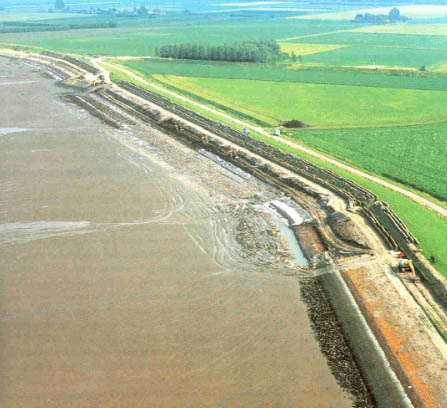| Western Scheldt estuary - The Netherlands |
| Complete description
of case study |
PHOTO OF THE SITE
 |
|
CASE STUDY
| Title | Western Scheldt estuary |
| National level | The Netherlands |
| Regional level | Delta |
ABSTRACT
|
The estuary can be characterized as a multiple channel system, separated by elongated tidal flats, where the main driving force of the system is the tide. Regular dredging at these sills is required in order to secure safe navigation to the port of Antwerp. Both natural and human factors have determined the present configuration. In general, the surface area of the estuary has decreased, mainly by land reclamation, dike reinforcement, but also because of the erosion caused by sea level rise, climate change and tidal cycles. Another type of human interference in the Scheldt estuary is dredging. A dredging strategy was chosen so that material dredged from the main channels was dumped into the side channels. Besides the safety of the hinterland, the leading factor in the further development of the Scheldt estuary seems to be the transport function of the estuary towards the port of Antwerp. The strategy consists preferably of soft measures. Locally, hard measures are adopted, if required. The negative effects on ecology, like the loss of inter-tidal habitats due to dredging and dumping, do have to be compensated for with rehabilitation works. This kind of project seems to be able to prevent further erosion and sometimes even stimulate sedimentation. In the future, the effects of the possible deepening of the channel and relative sea level rise will be the main causes of an increase in erosion. |
BASIC INFORMATION
| Coastal characteristics |
|
| Policy options | Hold
the line Move seaward (only in some locations) |
| Socio-economic activities | Industry, transport and energy, tourism and recreation, fisheries and aquaculture, nature conservation, agriculture. |
| Engineering techniques | Soft solutions: dredging/dumping , channel revetments, rehabilitation works for the intertidal salt marshes. |
SOURCE
| Name | Paul
Sistermans Odelinde Nieuwenhuis |
| Institution | DHV group |
| Address | Laan
1914 nr.35, 3818 EX Amersfoort PO Box 219 3800 AE Amersfoort – The Netherlands |
| Telephone / fax | +31 (0)33 468 37 00 / +31 (0)33 468 37 48 |
| paul.sistermans@dhv.nl odelinde.nieuwenhuis@dhv.nl |